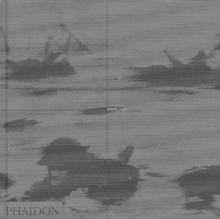Robert Capa (1913-1954), one of the greatest photographers of the twentieth century and a founding member of the Magnum photographic agency, had the mind of a passionate and committed journalist and the eye of an artist.
His lifework, consisting of more than 70,000 negative frames, constitutes an unparalleled documentation of a crucial twenty-two-year period (1932-1954) encompassing some of the most catastrophic and dramatic events of the last century.
This book represents the most definitive selection of Robert Capa's work ever published, a collection of 937 photographs selected by Capa's brother, Cornell Capa (himself a noted Life photographer), and his biographer, Richard Whelan, who meticulously re-examined all of Robert Capa's contact sheets to compile this master set of images.
This book opens with a biographical introduction illustrated with rare photographs of Capa, and closes with a chronology of his life.
The main body of the book presents this definitive collection of 937 of Robert Capa's most important pictures. The photographs, arranged in chronological order and accompanied by commentaries and identifying captions, constitute an in-depth survey of Robert Capa's finest work over the entire course of his career.
The pictures reveal the dramatic shifts in location and subject matter that Capa experienced from day to day, representing the trajectory of his life - from war-torn Spain to Picasso on a sunny beach in France; from carousing with Ernest Hemingway in London to Capa's historic images of the Allied landing on Omaha Beach in Normandy in 1944.
The book design groups together pictures that constitute a story - for example, the Popular Front rallies in Paris in 1936, or the U.S.
Army's entry into Sicily in 1943 - in order to maintain the original coherence of the work.
Embodying the spirit of his photographs, Robert Capa's life itself was adventurous, romantic, and tragic.
Born in Hungary in 1913, he hoped to become a journalist but was forced to flee to Berlin at the age of seventeen because of his leftist political sympathies.
When Hitler became chancellor of Germany in 1933, Capa fled to Paris, the city that would become his home on and off for most of his life. It was there that he met Andre Kertesz, who became a mentor to Capa and introduced him to the extraordinary potential of the 35mm Leica camera as a tool for reportage.
Capa also met two other photographers during his early years in Paris: Henri Cartier-Bresson and David "Chim" Szymin, with whom he founded Magnum, the co-operative photo agency, in 1947 along with George Rodger and William Vandivert.
For the rest of his life, Capa would devote much of his time to guiding the operations of the Magnum offices in Paris and New York.
Throughout the 1930s and World War II, Capa was present at many of the twentieth century's defining events and moments.
His first assignment came in 1932, when he was working as a darkroom assistant at Delphot, the important Berlin photo agency.
The agency's director, recognizing Capa's talent, lent him a camera and sent him to Copenhagen to photograph exiled Russian revolutionary Leon Trotsky giving a speech to Danish students.
From there, Robert Capa went on to photograph the Spanish Civil War, when he made his famous "Falling Soldier" picture showing a Republican soldier collapsing just after being shot. Capa reported on the increasing political tensions in Europe in the mid-1930s, including the Popular Front demonstrations in France, and on the presidential elections in Mexico in 1940 before being accredited by the U.S.
Army as a war correspondent for Life. After documenting Londoners' stalwart survival of the Blitz, he went on to cover battles on many of the major fronts in North Africa, Sicily, mainland Italy, France, and Germany.
In one of his most famous assignments, Capa landed with the first wave of American troops on Omaha Beach in Normandy on D-Day, June 6, 1944.
Wading into the frigid water behind amphibious tanks, and dodging machine gun and rifle bullets, Capa shot 36 exposures before his hands were shaking so badly that he could not insert another roll into the camera.
In an ironic twist of fate, a Life darkroom attendant damaged all but eleven of Capa's negatives.
After the war, he did various stories for travel magazines and worked on writing projects with friends such as John Steinbeck and the noted journalist Theodore H.
White. He also went to Israel several times to document the conflict and co-operation in the founding of the new nation. Capa's last assignment would be a trip to Vietnam to cover the French Indochina War: he was killed when he accidentally stepped on a Vietminh antipersonnel mine in the countryside on May 25, 1954.
Though perpetually broke, Capa lived a glamorous life - through a combination of charm, luck, and talent (and an uncontrollable penchant for gambling), he frequented a wealthy circle of celebrities and cultural figures.
He fell in love with Ingrid Bergman; was friends with Ernest Hemingway, the director John Huston, and other writers and directors; spent many an afternoon at the racetracks, and enjoyed all-night poker games.
Seen together, however, the pictures in this book transcend the specific situations they portray to stand as timeless images of the human condition at its most terrible and inspiring; they are monuments to the strength of the human spirit.

